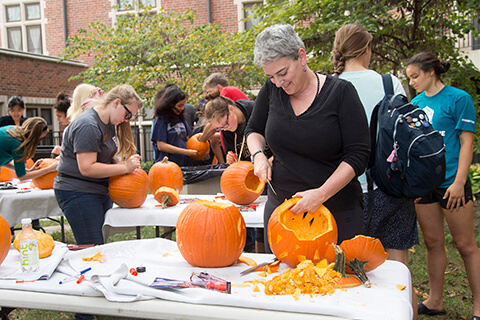November 7, 2017
Purdue Profiles: Tracey Jean Boisseau
 Tracey Jean Boisseau, associate professor of women’s, gender and sexuality studies, carves pumpkins with students outside Windsor Halls. Boisseau is faculty-in-residence in the Amelia Earhart Faculty-in-Residence program. (Purdue University photo/Mark Simons)
Download image
Tracey Jean Boisseau, associate professor of women’s, gender and sexuality studies, carves pumpkins with students outside Windsor Halls. Boisseau is faculty-in-residence in the Amelia Earhart Faculty-in-Residence program. (Purdue University photo/Mark Simons)
Download image
As a young person, Tracey Jean Boisseau felt most fully human when she was at school. The classroom was where she felt like she was a member of a community with a truly noble purpose -- to figure out how the world works and how to change it for the better. After realizing this purpose, she knew that she wanted to make school the place where she would spend her whole working life.
Boisseau now serves as an associate professor of women’s, gender and sexuality studies at Purdue. She served as the director of the WGSS program from 2012 to 2016 before going on leave as a Fulbright Scholar to Iceland. This fall, in addition to returning to the classroom, Boisseau has taken up a new position as a faculty-in-residence in the Amelia Earhart Faculty-in-Residence program.
What were your responsibilities during your time as director of the Women’s, Gender and Sexuality Studies Program?
As director of the WGSS program, I developed the vision and public messaging for the program and oversaw its day-to-day management, including budgeting, coordinating curriculum, advising students, supporting faculty as teachers and scholars and administering our major, two minor, and graduate concentrations. As director, I was also responsible for positioning the WGSS program to contribute to a campus culture where women and sexual minorities could both find true community and flourish as individuals.
What kinds of classes do you teach at Purdue?
As associate professor of WGSS, I teach a range of graduate and undergraduate classes. I mostly teach classes that fall into my area of research expertise, which is U.S. women’s history, visual studies and transnational feminism.
What inspired you to become a historian and gender studies scholar?
I chose to study history because, to me, historians seemed like they were the best at explaining the world and how it got to be the way it is. I realized that understanding how different the world used to be plays a large part in knowing how to change it in the future. Out of all the elements of historical study, the part that intrigued me the most was the history of gender as a lived reality and set of ideas. We can show through historical research that gender is a constructed category. If it is constructed, it can be deconstructed. History shows that we are capable of intentionally creating change to improve upon the ways that humans arrange themselves and relate to one another in order to create more justice, more equitable social relations and a greater and higher human condition. This is what I call feminism, and intersectional feminism is the project that animates my life as a scholar and a teacher. It is my hope that my work on this history will form a genuine contribution to our shared world.
What does your research focus on and why is it important?
My research has been focused on how women, particularly in the late 19th and early 20th centuries, used various forms of emergent mass media to promote themselves, promote feminist ideas and consciousness and produce feminist identity in a transnational context. I think this work is important because it allows us to understand the ways that feminism has all too often been co-opted, diluted and made to serve unjust and oppressive institutions of power. I see it as my responsibility, in the hope that we can forge a more revolutionary feminist future, to expose how and where potentially radical feminist ideas have been robbed of transformative potential. I think that is the most important work I can do, especially from my location as a relatively privileged, white American-born feminist historian.
This year you are serving as faculty-in-residence in University Residences' new Amelia Earhart Faculty-in-Residence program. Could you talk about the program and how you got involved?
Amelia Earhart’s role as a mentor and role model for female students is especially intriguing to me, as is her continued posthumous presence on our campus as a part of Purdue’s way of seeing itself and its mission. That is why the announcement that there was going to be a resurrection of her position as an embedded faculty member in the Windsor Residence Hall immediately caught my attention. At the same time, after several years serving primarily as an administrator, I found myself looking for more immediate and meaningful engagement with students.
My primary objective as the faculty-in-residence this year will be to carve out opportunities for “critical mentoring” and to serve as a bridge between the academic side of campus and residential life. I hope I can find ways to help students feel free to share with me their hopes and ambitions, their concerns and fears, and to give me a chance to help them find a way to flourish here at Purdue, and beyond.
Writer: Olivia Crouse, ocrouse@purdue.edu

